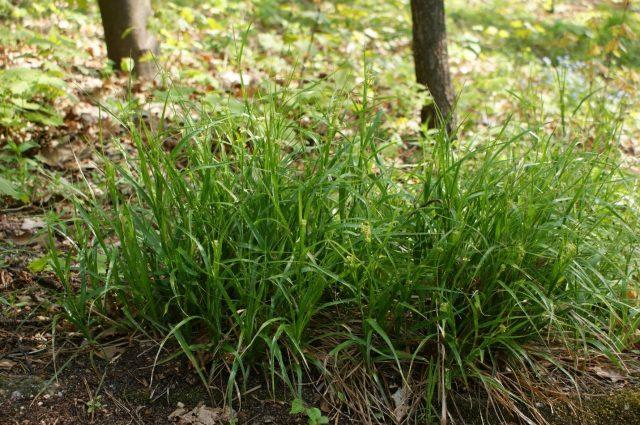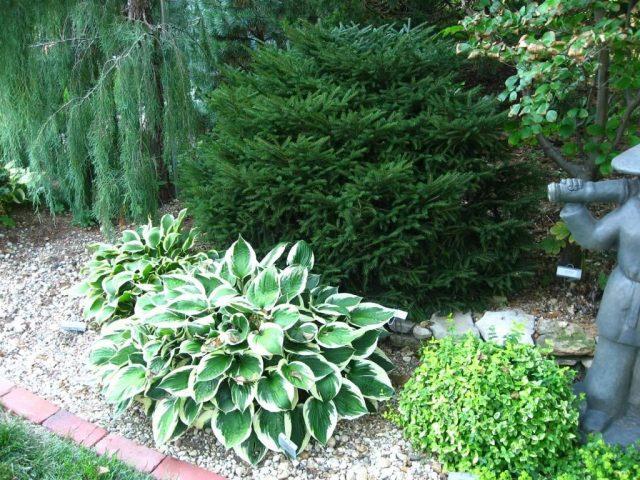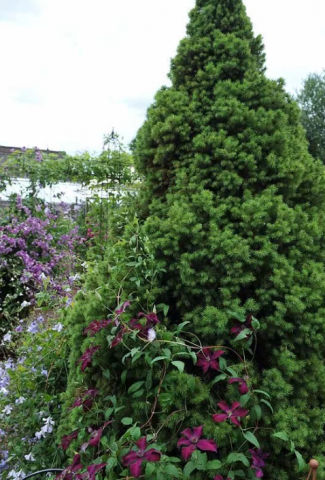Content
Spruce is a coniferous tree, popular both among professional landscape designers and amateur gardeners who want to decorate their site. It is valued for its ability to successfully withstand many negative external influences and ease of care. However, in solo plantings, many varieties of spruce look lonely. It is quite possible to find neighbors for them, but it is necessary to take into account that not just any plant can be planted next to a spruce. The microclimate in its tree trunk changes significantly.
Neighbors for spruce in the garden
Next to the Christmas tree, it is quite possible to create a flower bed or even a more complex landscape composition from decorative flowering and deciduous plants. "Companions" must be able to adapt to:
- Acidified substrate. Its pH is inevitably changed by falling needles.
- Lack of light. Most spruce trees have a fairly dense crown; only plants that can tolerate not even delicate partial shade, but dense shade can be planted next to it. In addition, when there is a lack of light in the circle around the tree trunk, high air humidity is inevitably created, and moss begins to actively grow.
- Constant competition for water and nutrients. The spruce root system quickly spreads in breadth, but remains superficial.It does not go deep into the soil; it receives everything it needs for growth and development from shallow layers of the substrate. The pulling process is very active; the plants that are planned to be planted nearby must find other sources of nutrition.

If you plant crops next to the Christmas tree without taking into account their requirements for growing conditions, there is a high probability that they will die
What can be planted next to a spruce tree in the garden
The range of plants that can be planted next to the spruce is quite diverse. Both flowering and decorative deciduous crops, annuals and perennials can withstand its proximity.
Perennial flowers and plants
Perennial flowering and decorative leafy crops, if planted next to a spruce tree, are a good solution to the problem of camouflaging the gradually exposed lower part of its trunk. You just need to take into account their dimensions so that in the future they do not outgrow an adult Christmas tree.
What perennials can be planted nearby:
- Ferns. In nature, these plants coexist peacefully and successfully. Ferns are very suitable for acidified soil, constant soil moisture, and lack of light.
If you plant ferns next to a Christmas tree, they quickly grow, forming islands of bright, lacy greenery
- Ozhika forest and snow. Herbaceous perennials, often found near spruce trees in natural conditions. Both plants are not too tall (25-30 cm) and are distinguished by the presence of ciliated leaves. Inflorescences are white panicles.
Any variety of ozhika can be moved from the forest and planted next to a spruce tree in the garden - it will easily take root in a new place
- Hosta. It does not particularly suffer from lack of light, loves high soil moisture, and grows normally in acidified soil. If you plant it under a Christmas tree, you should not expect abundant flowering, but the vast majority of gardeners value hosta for its bright, lush greenery.
Khosta is distinguished by its varietal diversity: it is not difficult to choose options to plant next to decorative spruce trees of different colors.
- Delphinium. A tall (1.5-2 m) plant, which is best planted next to a wall or other barrier so that the stems do not break from the wind. They are usually placed in bunches of 3-5 pieces, creating peculiar torches next to the spruce trees.
Delphiniums are distinguished by abundant flowering and a rich range of colors.
- Clematis. A climbing vine with large flowers. Clematis should be planted directly under the tree, and then the shoots should be directed along the trunk when they stretch 50-70 cm and tied to the lower branches.
If you plant clematis next to the Christmas tree, it will be New Year's all year round
Coniferous plants
The simplest and most obvious solution in landscape design is to create a composition from only coniferous plants. They have similar requirements for substrate quality and agricultural technology. And thanks to the variety of shapes and colors of the hybrids bred by breeders, such a composition will definitely not be gloomy.
What conifers can be planted next to the Christmas tree:
- Prickly spruce Hoopsie. The brightest blue spruce in existence. Young seedlings have light blue needles; as the tree matures, they acquire a silvery-gray tint. If you plant it next to a classic blue spruce, it will create a very impressive contrast with the dark pine needles.
The Hupsy spruce grows slowly - in 30 years it reaches a height of 10 meters with a crown circumference of 3.5-4 m
- Spruce Inversa. One of the most original varieties with a weeping crown. Its lower branches practically lie on the ground. Young needles at the tips of the branches are bright green, changing to a deep emerald shade as they grow. The dimensions of the tree are 6-8 m in height with a crown diameter of 2-2.5 m.
Inverse spruce can be given any desired height, proportioning it to the plants planted nearby
- Dwarf spruces. The varieties bred by breeders are distinguished by great diversity in the color of their needles and the shape of their crown. As a rule, they grow very slowly and feel great if planted under the crown of a classic Christmas tree.
Dwarf spruce trees rarely extend more than 1 m in height
- Juniper. Decorative effect is provided not only by the needles of the original shade, but also by numerous berries. Most junipers are not characterized by large size and rapid growth rates.
A serious drawback of juniper is that it is a carrier of rust.
- Thuja. Of all the conifers, it is the most diverse in appearance. It is distinguished by an unusual type of needles that resemble scales.
Thuja for planting next to a spruce must be chosen so that they match either the color of the needles or the shape of the crown.”
Ornamental shrubs
Spruce is an excellent “background” for flowering and decorative deciduous shrubs. If you plant them next to such a background, the inflorescences and original coloring of the leaves will look even more advantageous.
Suitable companions:
- Barberry.The most common solution in landscape design is a hedge made of spruce, which is duplicated by a border made of barberry. Almost any dwarf variety can be planted next to it.
Barberry Rose Glow, Bogatelle, Cobolt look very elegant and are extremely easy to care for
- Forsythia. Blooms in early spring, even before the leaves bloom. If you plant it next to spruce trees, even at the beginning of the season they will not look like a solid green spot.
In spring, the branches of forsythia are literally dotted with sunny yellow flowers.
- Deren. Able to adapt to different light levels and substrate quality. Easily tolerates haircuts. Decorative throughout the year thanks to its unusual glossy bark, iridescent in different shades of crimson, ocher, lemon, olive green.
If you plant a variegated turf next to it, its leaves may change their shade to normal green due to a lack of light.
- Hydrangea. For normal growth and development, it needs frequent watering and loves acidic soil. Not all varieties can tolerate dense shade, but there are some as well.
Large hydrangea inflorescences against the background of dark needles look very impressive
Cereals
Cereals in combination with spruce trees look unusual. But, since it is problematic to create a classic lawn under it, sowing cereals may well be a solution.
Suitable for planting next to a spruce:
- Fescue. Forms balls with a diameter of up to 0.5-0.8 m. The leaves are rough-hairy to the touch, silvery-gray. Inflorescences are paniculate, medium-sized.
Most often, gardeners choose red and meadow fescue to plant next to spruce.
- Kolosnyak. The stems are tall (0.3-1.5 m), erect. The leaves are creeping, almost lying on the ground.
Many decorative varieties of grate have leaves with an original bluish-blue tint
- Miscanthus. Tall (about 2 m) plant. The leaves are narrow and numerous. As they ripen, the inflorescences bloom beautifully.
Miscanthus, if planted next to a spruce, looks very advantageous due to the fact that it retains its decorative effect from mid-spring until frost
- The forest is spreading. It is very suitable for planting next to a spruce tree, as it prefers moist soil. Inflorescences are large, loose panicles.
Spreading boron Aureum is one of the most popular varieties
What plants should not be planted under a spruce tree?
Obviously, the principles of compatibility between spruce, ornamental shrubs and other garden crops, based on the requirements for growing conditions, exclude planting light-loving plants next to them that cannot tolerate acidified, waterlogged soil. Unsuitable companions:
- Any fruit and berry trees. It is a particularly bad idea to try to plant a young seedling next to an adult spruce tree. It is guaranteed not to withstand competition for water and nutrients and will die in 1-2 seasons. If you plant a small spruce next to an adult tree, it will last longer, but eventually it will still stop bearing fruit and dry out.
- Most flowering annuals. They need sunlight to bloom brightly and abundantly. They also react poorly to high soil moisture.
- Tomatoes, cucumbers, potatoes. All these crops need fertile soil; humus or rotted compost must be added to them. Spruce trees do not like such fertile soil. If you plant it next to such beds, it quickly loses its presentability, the needles become bald and become covered with rust.
Conclusion
There are quite a lot of decorative deciduous and flowering crops that can be planted next to spruce. The variety of plants allows you to create original compositions that fit into different styles of landscape design. However, the first thing to consider when choosing companions is not their visual compatibility, but the ability to grow and develop normally in the conditions created by the spruce tree in the tree trunk.


























